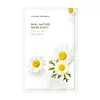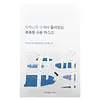What's inside
What's inside
 Key Ingredients
Key Ingredients

 Benefits
Benefits

 Concerns
Concerns

No concerns
 Ingredients Side-by-side
Ingredients Side-by-side

Water
Skin ConditioningGlycerin
HumectantDipropylene Glycol
HumectantAlcohol
AntimicrobialHydroxyethylcellulose
Emulsion StabilisingButylene Glycol
Humectant1,2-Hexanediol
Skin ConditioningPaeonia Suffruticosa Root Extract
Skin ProtectingCentella Asiatica Extract
CleansingTrehalose
HumectantPEG-60 Hydrogenated Castor Oil
EmulsifyingChamomilla Recutita Flower Extract
MaskingAnthemis Nobilis Flower Extract
MaskingGlyceryl Caprylate
EmollientArginine
MaskingCarbomer
Emulsion StabilisingEthylhexylglycerin
Skin ConditioningSodium Hyaluronate
HumectantGlyceryl Acrylate/Acrylic Acid Copolymer
HumectantPvm/Ma Copolymer
Emulsion StabilisingCamellia Sinensis Leaf Extract
AntimicrobialSophora Angustifolia Root Extract
Skin ConditioningLonicera Japonica Flower Extract
Skin ConditioningPrunus Persica Leaf Extract
EmollientPaeonia Albiflora Root Extract
Skin ConditioningGinkgo Biloba Leaf Extract
Skin ConditioningScutellaria Baicalensis Root Extract
AstringentDisodium EDTA
Parfum
MaskingWater, Glycerin, Dipropylene Glycol, Alcohol, Hydroxyethylcellulose, Butylene Glycol, 1,2-Hexanediol, Paeonia Suffruticosa Root Extract, Centella Asiatica Extract, Trehalose, PEG-60 Hydrogenated Castor Oil, Chamomilla Recutita Flower Extract, Anthemis Nobilis Flower Extract, Glyceryl Caprylate, Arginine, Carbomer, Ethylhexylglycerin, Sodium Hyaluronate, Glyceryl Acrylate/Acrylic Acid Copolymer, Pvm/Ma Copolymer, Camellia Sinensis Leaf Extract, Sophora Angustifolia Root Extract, Lonicera Japonica Flower Extract, Prunus Persica Leaf Extract, Paeonia Albiflora Root Extract, Ginkgo Biloba Leaf Extract, Scutellaria Baicalensis Root Extract, Disodium EDTA, Parfum
Water
Skin ConditioningGlycerin
HumectantMethylpropanediol
SolventPropanediol
SolventBetula Platyphylla Japonica Juice
Skin ConditioningHydroxyacetophenone
AntioxidantCarbomer
Emulsion StabilisingTromethamine
BufferingAllantoin
Skin ConditioningCaffeine
Skin ConditioningPolyglyceryl-10 Laurate
Skin ConditioningPolyglyceryl-10 Myristate
Skin ConditioningButylene Glycol
HumectantCaprylyl Glycol
EmollientXanthan Gum
EmulsifyingEthylhexylglycerin
Skin Conditioning1,2-Hexanediol
Skin ConditioningDipotassium Glycyrrhizate
HumectantSodium Hyaluronate
HumectantDisodium EDTA
Althaea Rosea Flower Extract
Skin ConditioningGlyceryl Caprylate
EmollientWater, Glycerin, Methylpropanediol, Propanediol, Betula Platyphylla Japonica Juice, Hydroxyacetophenone, Carbomer, Tromethamine, Allantoin, Caffeine, Polyglyceryl-10 Laurate, Polyglyceryl-10 Myristate, Butylene Glycol, Caprylyl Glycol, Xanthan Gum, Ethylhexylglycerin, 1,2-Hexanediol, Dipotassium Glycyrrhizate, Sodium Hyaluronate, Disodium EDTA, Althaea Rosea Flower Extract, Glyceryl Caprylate
 Reviews
Reviews

Ingredients Explained
These ingredients are found in both products.
Ingredients higher up in an ingredient list are typically present in a larger amount.
1,2-Hexanediol is a synthetic liquid and another multi-functional powerhouse.
It is a:
- Humectant, drawing moisture into the skin
- Emollient, helping to soften skin
- Solvent, dispersing and stabilizing formulas
- Preservative booster, enhancing the antimicrobial activity of other preservatives
Butylene Glycol (or BG) is used within cosmetic products for a few different reasons:
Overall, Butylene Glycol is a safe and well-rounded ingredient that works well with other ingredients.
Though this ingredient works well with most skin types, some people with sensitive skin may experience a reaction such as allergic rashes, closed comedones, or itchiness.
Learn more about Butylene GlycolCarbomer is a polymer of acrylic acid. Its main role is to create a gel consistency.
A high amount of carbomer can cause pilling or balling up of products. Don't worry, most products contain 1% or less of carbomer.
Disodium EDTA plays a role in making products more stable by aiding other preservatives.
It is a chelating agent, meaning it neutralizes metal ions that may be found in a product.
Disodium EDTA is a salt of edetic acid and is found to be safe in cosmetic ingredients.
Learn more about Disodium EDTAEthylhexylglycerin (we can't pronounce this either) is commonly used as a preservative and skin softener. It is derived from glyceryl.
You might see Ethylhexylglycerin often paired with other preservatives such as phenoxyethanol. Ethylhexylglycerin has been found to increase the effectiveness of these other preservatives.
Glycerin is already naturally found in your skin. It helps moisturize and protect your skin.
A study from 2016 found glycerin to be more effective as a humectant than AHAs and hyaluronic acid.
As a humectant, it helps the skin stay hydrated by pulling moisture to your skin. The low molecular weight of glycerin allows it to pull moisture into the deeper layers of your skin.
Hydrated skin improves your skin barrier; Your skin barrier helps protect against irritants and bacteria.
Glycerin has also been found to have antimicrobial and antiviral properties. Due to these properties, glycerin is often used in wound and burn treatments.
In cosmetics, glycerin is usually derived from plants such as soybean or palm. However, it can also be sourced from animals, such as tallow or animal fat.
This ingredient is organic, colorless, odorless, and non-toxic.
Glycerin is the name for this ingredient in American English. British English uses Glycerol/Glycerine.
Learn more about GlycerinGlyceryl Caprylate comes from glycerin and caprylic acid, a fatty acid from coconut. It has emollient and emulsifier properties.
As an emollient, it helps hydrate your skin. Emollients work by creating a barrier on your skin to trap moisture in, helping to keep your skin soft and smooth.
On the other hand, emulsifiers prevent ingredients (such as oil and water) from separating.
Learn more about Glyceryl CaprylateSodium Hyaluronate is hyaluronic acid's salt form. It is commonly derived from the sodium salt of hyaluronic acid.
Like hyaluronic acid, it is great at holding water and acts as a humectant. This makes it a great skin hydrating ingredient.
Sodium Hyaluronate is naturally occurring in our bodies and is mostly found in eye fluid and joints.
These are some other common types of Hyaluronic Acid:
Learn more about Sodium HyaluronateWater. It's the most common cosmetic ingredient of all. You'll usually see it at the top of ingredient lists, meaning that it makes up the largest part of the product.
So why is it so popular? Water most often acts as a solvent - this means that it helps dissolve other ingredients into the formulation.
You'll also recognize water as that liquid we all need to stay alive. If you see this, drink a glass of water. Stay hydrated!
Learn more about Water